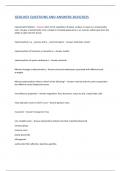APARTHIED
,CIVIL SOCIETY PROTEST IN SA (1970s )
STEVE BIKO AND THE BCM
THE SILENT 60s
During the 60s there was little resistance to apartheid. The NP crushed all
resistance methods
ANC and PAC were banned in 1960 due to the unlawful organisations act
1964 leaders of the ANC and MK were arrested at the Rivonia trial
Many leaders fled into exile
South Africa became a police state with its media controlled. However the rise
of the BCM in the 1970s changed this
Active involvement from youth, students and workers
ANC played a limited role because their power was limited by the state
THE ORIGINS OF BC
Began in 1970s
Aimed to make black people proud of their culture
Liberation for black people would only come if they stopped thinking
they were inferior
Self-determination and self-liberation
Black people were subject to internal forces (believing they were
inferior) and external forces (the apartheid system)
The BCM rejected white liberals because they did not experience what black
people did
Steve Biko was the driving force
Involved in the national union of south African students (NUSAS)
Which only catered for white needs
1968 Biko formed south African students organisation (SASO)
AIMS OF THE BCM
Increase self-respect and confidence of black people
Pride in identity, culture, and history
Self-reliance
, Unity among black people
Biko was influenced by:
Black panthers
Anton Lembede ANC YL president
Student protest movement
Growing independence of African states
Ideas of PAC (pan-Africanism)
By 1971 the BCM had grown:
Black peoples convention (BPC) made in 1972
Black communities programmes (BCP) made in 1972
Biko was expelled from Natal university
1973 Biko helped form the black allied workers union (BAWU)
ACHIEVEMENTS OF THE BCM
BCP organised self-help schemes
These projects empowered black people
Bikos leadership influenced the youth to take action
Took a leadership role as most of the ANC and PAC were in exile
SASM (south African students movement) organised Soweto riots in
1976 and was linked to the BCM
The BCM boosted the trade union movement:
Strikes in 1973 such as textile mills in Pinetown and other industries in
Durban
Wiehahn commission and Riekert Act in 1979 legalised trade unions
which eventually led to the relaxation of the pass laws
1976 SOWETO UPRISINGS
,CIVIL SOCIETY PROTEST IN SA (1970s )
STEVE BIKO AND THE BCM
THE SILENT 60s
During the 60s there was little resistance to apartheid. The NP crushed all
resistance methods
ANC and PAC were banned in 1960 due to the unlawful organisations act
1964 leaders of the ANC and MK were arrested at the Rivonia trial
Many leaders fled into exile
South Africa became a police state with its media controlled. However the rise
of the BCM in the 1970s changed this
Active involvement from youth, students and workers
ANC played a limited role because their power was limited by the state
THE ORIGINS OF BC
Began in 1970s
Aimed to make black people proud of their culture
Liberation for black people would only come if they stopped thinking
they were inferior
Self-determination and self-liberation
Black people were subject to internal forces (believing they were
inferior) and external forces (the apartheid system)
The BCM rejected white liberals because they did not experience what black
people did
Steve Biko was the driving force
Involved in the national union of south African students (NUSAS)
Which only catered for white needs
1968 Biko formed south African students organisation (SASO)
AIMS OF THE BCM
Increase self-respect and confidence of black people
Pride in identity, culture, and history
Self-reliance
, Unity among black people
Biko was influenced by:
Black panthers
Anton Lembede ANC YL president
Student protest movement
Growing independence of African states
Ideas of PAC (pan-Africanism)
By 1971 the BCM had grown:
Black peoples convention (BPC) made in 1972
Black communities programmes (BCP) made in 1972
Biko was expelled from Natal university
1973 Biko helped form the black allied workers union (BAWU)
ACHIEVEMENTS OF THE BCM
BCP organised self-help schemes
These projects empowered black people
Bikos leadership influenced the youth to take action
Took a leadership role as most of the ANC and PAC were in exile
SASM (south African students movement) organised Soweto riots in
1976 and was linked to the BCM
The BCM boosted the trade union movement:
Strikes in 1973 such as textile mills in Pinetown and other industries in
Durban
Wiehahn commission and Riekert Act in 1979 legalised trade unions
which eventually led to the relaxation of the pass laws
1976 SOWETO UPRISINGS








